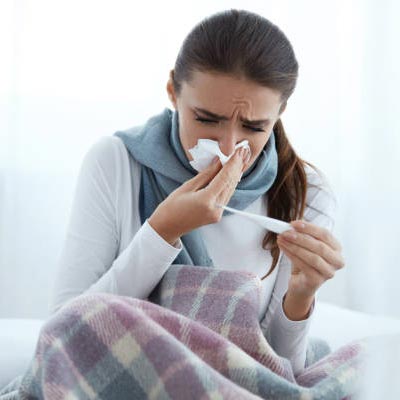Fever is a common symptom that often indicates an underlying medical condition. It is the body's natural response to infections, inflammation, or other health issues. In this comprehensive guide, we will delve into the specifics of fever and explore four tropical diseases - Dengue, Malaria, Typhoid, and Chikungunya. We will discuss the causes, symptoms, preventions, and treatments for each, providing valuable insights for general physicians and individuals seeking information on these health concerns.
What is Fever?
Fever is defined as an elevated body temperature above the normal range, typically around 98.6°F (37°C). It is the body's defense mechanism against infections, as many pathogens thrive at normal body temperatures. The hypothalamus, a part of the brain, acts as the body's thermostat, regulating temperature. When the immune system detects an invader, it releases chemicals that signal the hypothalamus to increase the body's temperature, creating an environment less conducive to the pathogen's survival.

What is Viral Fever?
Viral fever is a term used to describe a fever that results from a viral infection rather than a bacterial one. When viruses invade the body, they trigger the immune system to respond, leading to an increase in body temperature.
Symptoms of Viral Fever
- High fever
- Headache
- Body aches
- Fatigue
- Cough
- Sore throat
- Runny or stuffy nose
- Nausea or vomiting
- Diarrhea (in some cases)
Types Of Fevers
Dengue
Dengue fever is a mosquito-borne viral infection caused by the dengue virus. Commonly found in tropical and subtropical regions, the Aedes aegypti mosquito serves as the primary vector. Symptoms include high fever, severe headache, pain behind the eyes, joint and muscle pain, rash, and mild bleeding. In severe cases, it can lead to dengue hemorrhagic fever or dengue shock syndrome.
Prevention of Dengue
Preventing dengue involves controlling mosquito populations and avoiding mosquito bites. Measures include using mosquito repellents, wearing long-sleeved clothing, and using bed nets. Eliminating standing water where mosquitoes breed is crucial. In regions where dengue is prevalent, vaccination is also an effective preventive measure
Treatment for Dengue
There is no specific antiviral treatment for dengue. Management involves supportive care, such as adequate fluid intake to prevent dehydration. Severe cases may require hospitalization for intravenous fluids and other supportive measures.
Malaria
Malaria is a parasitic infection transmitted through the bite of infected female Anopheles mosquitoes. Plasmodium parasites cause the disease, with Plasmodium falciparum being the most deadly species. Symptoms include fever, chills, sweating, headache, and fatigue. Malaria can be severe and potentially fatal if not diagnosed and treated promptly.
Prevention of Malaria
Preventive measures include the use of antimalarial drugs, insecticide-treated bed nets, and mosquito repellents. Travelers to malaria-endemic regions are advised to take prophylactic medications. Additionally, efforts to control mosquito populations through insecticide spraying and environmental management are crucial.
Treatment for Malaria
Treatment involves antimalarial medications, with the specific drug depending on the Plasmodium species causing the infection. Early diagnosis and prompt treatment are essential to prevent complications.
Typhoid
Typhoid fever is a bacterial infection caused by Salmonella typhi. Contaminated food and water are common sources of infection. Symptoms include prolonged high fever, headache, abdominal pain, and constipation or diarrhea. Severe cases can lead to intestinal perforation, a life-threatening complication.
Prevention of Typhoid
Preventive measures include practicing good hygiene, ensuring the safety of water sources, and consuming only properly cooked food. Typhoid vaccines are also available and recommended for travelers to areas with a high prevalence of the disease.
Treatment for Typhoid
Antibiotics are the primary treatment for typhoid fever. Prompt diagnosis and appropriate antibiotic therapy are crucial to prevent complications and reduce the duration of illness.
Chikungunya
Chikungunya is a viral infection transmitted by Aedes mosquitoes, similar to dengue. Symptoms include sudden onset of high fever, joint pain, headache, muscle pain, and rash. While rarely fatal, chikungunya can cause debilitating joint pain that may persist for months.
Prevention of Chikungunya
Preventive measures involve avoiding mosquito bites through the use of repellents, wearing protective clothing, and eliminating breeding sites. As there is no specific vaccine for chikungunya, prevention primarily focuses on mosquito control.
Treatment for Chikungunya
There is no specific antiviral treatment for chikungunya. Management includes relieving symptoms through rest, hydration, and pain medications. Severe cases may require hospitalization for supportive care.
COVID-19
COVID-19, caused by the novel coronavirus, is a highly contagious respiratory illness. It emerged in late 2019 and spread globally, leading to a pandemic. Symptoms include fever, cough, and difficulty breathing. Preventive measures like wearing masks, hand hygiene, and social distancing help curb transmission. Vaccines are also crucial in controlling the spread. Stay informed through reliable sources like the CDC for updates on COVID-19
Fever is a common symptom that can be associated with various underlying conditions. Understanding specific diseases like Dengue, Malaria, Typhoid, and Chikungunya is crucial for both healthcare professionals and the general public. Prevention strategies and early diagnosis play pivotal roles in managing these tropical diseases effectively. As global travel increases, awareness of these health concerns becomes even more critical to prevent outbreaks and protect public health. General physicians should remain vigilant, staying informed about the latest developments in the prevention and treatment of these diseases to provide optimal care to their patients.
